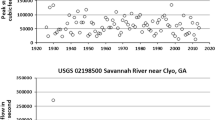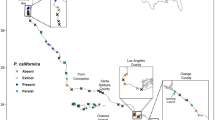Abstract
Destruction of tidal wetlands has led to a growing interest in the restoration and creation of new wetland habitat. However, while natural stands of vegetation have been successfully duplicated, less is understood about the establishment of faunal communities in created or restored tidal marshes. Infauna, which may form an important link between detrital production and commercially important finfish and decapods, have received limited attention in vegetated marsh habitats. We examined the infauna, changes in vegetation composition, and selected physical parameters in created marshes of different ages. Infauna were sampled using standard core sampling techniques. Vegetation composition and changes in relative abundance were observed using plot-point techniques. Vegetation plots indicated ongoing replacement ofSpartina alterniflora bySchoenoplectus robustus, a pattern supported by comparisons of vegetation at one of the sites to that reported in a previous study. Infauna exhibited significant differences between sites of different ages, with the intermediate-age site having intermediate densities for several taxa. These results suggest that both infauna and vegetation in created marshes undergo long-term change (ongoing after 10–20 yr), with both the plant and infaunal communities having qualitatively similar overall species composition to natural marsh areas.
Similar content being viewed by others
Literature Cited
Bishop, T. D. andC. T. Hackney. 1987. A comparative study of the mollusc communities of two oligohaline intertidal marshes: Spatial and temporal distribution of abundance and biomass.Estuaries 10:141–152.
Broome, S. W., E. D. Seneca, andW. W. Woodhouse. 1988. Tidal salt marsh restoration.Aquatic Botany 32:1–22.
Cammen, L. M. 1976. Macroinvertebrate colonization ofSpartina marshes artificially established on dredge spoil.Estuarine and Coastal Marine Sciences 4:357–372.
Capehart, A. A. andC. T. Hackney. 1989. The potential role of roots and rhizomes in structuring salt marsh benthic communities.Estuaries 12:119–122.
Fox, R. S. andE. E. Ruppert. 1985. Shallow-Water Marine Benthic Macroinvertebrates of South Carolina. University of South Carolina Press, Columbia, South Carolina.
Gallagher, E. D., P. A. Jumars, andD. D. Trueblood. 1983. Facilitation of soft-bottom benthic succession by tube builders.Ecology 64:1200–1216.
Gonor, J. J. andP. F. Kemp. 1978. Procedures for quantitative ecological assessment in intertidal environments. United States Environmental Protection Agency, Washington, D.C. EPA-600/3-78-087.
Heard, R. W. 1982. Guide to common tidal marsh invertebrates of the northeastern Gulf of Mexico. Mississippi-Alabama Sea Grant Consortium, Biloxi, Mississippi.
Kneib, R. T. 1984. Patterns of invertebrate distribution and abundance in the intertidal salt marsh: Causes and questions.Estuaries 7:392–412.
Kneib, R. T. andA. E. Stiven. 1978. Growth, reproduction, and feeding ofFundulus heteroclitus (L.) on a North Carolina salt marsh.Journal of Experimental Marine Biology and Ecology 31: 121–140.
LaSalle, M. W., M. C. Landin, andJ. G. Sims. 1991. Evaluation of the flora and fauna ofSpartina alterniflora marsh established on dredged material in Winyah Bay, South Carolina.Wetlands 11:191–208.
Matthews, G. A. andT. J. Minello. 1994. Technology and success in restoration, creation, and enhancement ofSpartina alterniflora marshes in the United States. Vol. 1—Executive Summary and Annotated Bibliography. National Oceanographic and Atmospheric Administration Coastal Ocean Program Decision Analysis Series. No. 2. National Oceanographic and Atmospheric Administration Coastal Ocean Office, Silver Spring, Maryland.
Miltner, R. J., S. W. Ross, andM. H. Posey. 1995. Influence of food and predation on the depth distribution of the juvenile spot (Leiostomus xanthurus) in tidal marshes.Canadian Journal of Fisheries and Aquatic Sciences 52:971–982.
Minello, T. J. andR. J. Zimmerman. 1992. Utilization of natural and transplanted Texas salt marshes by fish and decapod crustaceans.Marine Ecology Progress Series 90:273–285.
Minello, T. J., R. J. Zimmerman, andR. Medina. 1994. The importance of edge for natant macrofauna in a created salt marsh.Wetlands 14:184–198.
Mitsch, W. J. andJ. G. Gosselink. 1986. Wetlands. Van Nostrand Reinhold, New York.
Moy, L. D. andL. A. Levin. 1991. AreSpartina marshes a replaceable resource? A functional approach to evaluation of marsh creation efforts.Estuaries 14:1–16.
Posey, M. H., C. Wigand, andJ. C. Stevenson. 1993. Effects of an introduced aquatic plant,Hydrilla verticillata, on benthic communities in the upper Chesapeake Bay.Estuarine Coastal and Shelf Science 37:539–555.
Rozas, L. P. andD. J. Reed. 1993. Nekton use of marsh-surface habitats in Louisiana (USA) deltaic salt marshes undergoing submergence.Marine Ecology Progress Series 96:147–157.
Sokal, R. R. andF. J. Rohlf. 1981. Biometry. W.H. Freeman, San Francisco, California.
Subrahmanyam, C. B., W. L. Kruczynski, andS. H. Drake. 1976. Studies on the animal communities in two north Florida salt marshes. Part II. Macroinvertebrate communities.Bulletin of Marine Sciences 26:172–195.
Talbot, C. W. andK. W. Able. 1984. Composition and distribution of larval fishes in New Jersey high marshes.Estuaries 7:434–443.
Wenner, E. L. andH. R. Beatty. 1988. Macrobenthic communities from wetland impoundments and adjacent open marsh habitats in South Carolina.Estuaries 11:29–44.
Wheeler, T. L. 1993. Patterns of early succession on a dredged material marsh island in Winyah Bay, South Carolina. M.S. Thesis, University of North Carolina at Wilmington, North Carolina.
Wiltse, W. I., K. H. Foreman, J. M. Teal, andI. Valiela. 1984. Effects of predators and food resources on the macrobenthos of salt marsh crecks.Journal of Marine Research 42:923–942.
Author information
Authors and Affiliations
Corresponding author
Rights and permissions
About this article
Cite this article
Posey, M.H., Alphin, T.D. & Powell, C.M. Plant and infaunal communities associated with a created marsh. Estuaries 20, 42–47 (1997). https://doi.org/10.2307/1352718
Received:
Accepted:
Issue Date:
DOI: https://doi.org/10.2307/1352718




